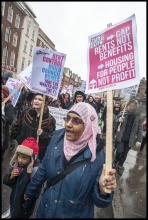
Photo Paul Mattsson
Between June 2014 and 2015, average private rents in Britain increased by 2.5%, according to the Office for National Statistics (ONS). The biggest price hike of 3.8% was in London, with Scotland experiencing a 2.1% rise.
Meanwhile, the flatshare website Spareroom.co.uk found that rent in every London postcode is now “unaffordable” for those workers on the ‘living wage’ of £9.15 an hour.
Spareroom’s survey found that incomes of those on the London living wage, after tax, amounts to £293 a week. Yet the average weekly room rent in the last year rose by 6% (higher than the ONS figure) to £164.31, ie 56% of disposable income.
Astonishingly, published research shows that a renter in Camden Town, working in Liverpool Street, would be £403 a month better off if they moved to Madrid and commuted back!
One adverse effect on public services of the lack of affordable housing in London has been a 66% rise in the number of ambulance workers leaving the service over the last three years.
The number of both private and council tenants with rent arrears is also growing as a result of rent hikes and the ‘bedroom tax’. A National Debtline spokesperson said: “We have seen the proportion of clients seeking help with rent arrears double from 6% in 2007 to nearly 13% in 2014.”
The housing crisis is a toxic mix of unregulated private rents, council housing sell-offs (now extended to housing associations), the bedroom tax, and the lowest number of houses both public and private being built since the 1920s.
Even the Tory leader of Westminster council reckons that newly built council homes in regeneration schemes are likely to be sold off by boroughs because their location makes them ‘too valuable’.
However, this government, which represents the super-rich, refuses to reinstate rent controls, invest in council housing, and end the price speculation in land and property by ‘investors’ (which include properties bought by money laundering criminals and sanctions-avoiding oligarchs, etc, using front companies).






